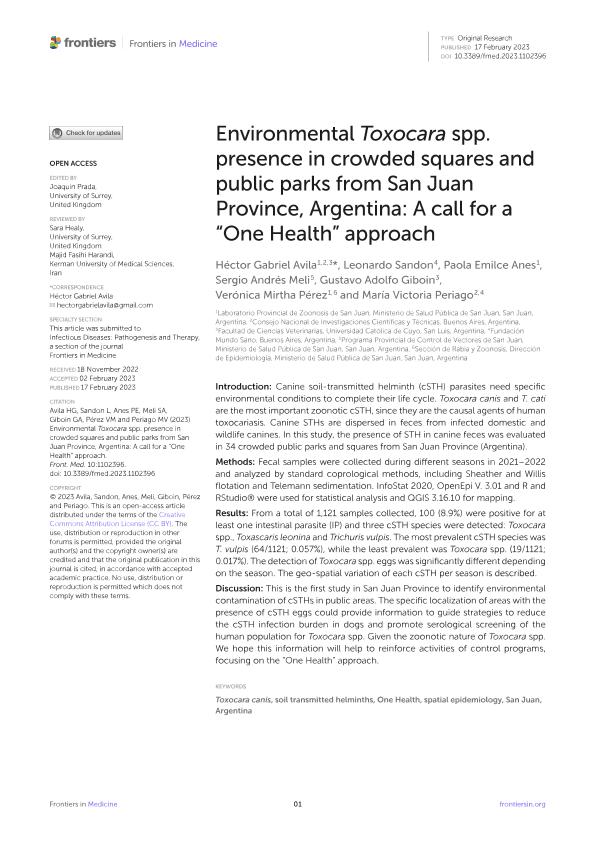Artículo
Environmental Toxocara spp. presence in crowded squares and public parks from San Juan Province, Argentina: A call for a “One Health” approach
Avila, Héctor Gabriel ; Sandon, Leonardo; Anes, Paola Emilce; Meli, Sergio Andrés; Giboin, Gustavo Adolfo; Pérez, Verónica Mirtha; Periago, Maria Victoria
; Sandon, Leonardo; Anes, Paola Emilce; Meli, Sergio Andrés; Giboin, Gustavo Adolfo; Pérez, Verónica Mirtha; Periago, Maria Victoria
 ; Sandon, Leonardo; Anes, Paola Emilce; Meli, Sergio Andrés; Giboin, Gustavo Adolfo; Pérez, Verónica Mirtha; Periago, Maria Victoria
; Sandon, Leonardo; Anes, Paola Emilce; Meli, Sergio Andrés; Giboin, Gustavo Adolfo; Pérez, Verónica Mirtha; Periago, Maria Victoria
Fecha de publicación:
02/2023
Editorial:
Frontiers Media
Revista:
Frontiers in Medicine
ISSN:
2296-858X
Idioma:
Inglés
Tipo de recurso:
Artículo publicado
Clasificación temática:
Resumen
Introduction: Canine soil-transmitted helminth (cSTH) parasites need specific environmental conditions to complete their life cycle. Toxocara canis and T. cati are the most important zoonotic cSTH, since they are the causal agents of human toxocariasis. Canine STHs are dispersed in feces from infected domestic and wildlife canines. In this study, the presence of STH in canine feces was evaluated in 34 crowded public parks and squares from San Juan Province (Argentina). Methods: Fecal samples were collected during different seasons in 2021–2022 and analyzed by standard coprological methods, including Sheather and Willis flotation and Telemann sedimentation. InfoStat 2020, OpenEpi V. 3.01 and R and RStudio® were used for statistical analysis and QGIS 3.16.10 for mapping. Results: From a total of 1,121 samples collected, 100 (8.9%) were positive for at least one intestinal parasite (IP) and three cSTH species were detected: Toxocara spp., Toxascaris leonina and Trichuris vulpis. The most prevalent cSTH species was T. vulpis (64/1121; 0.057%), while the least prevalent was Toxocara spp. (19/1121; 0.017%). The detection of Toxocara spp. eggs was significantly different depending on the season. The geo-spatial variation of each cSTH per season is described. Discussion: This is the first study in San Juan Province to identify environmental contamination of cSTHs in public areas. The specific localization of areas with the presence of cSTH eggs could provide information to guide strategies to reduce the cSTH infection burden in dogs and promote serological screening of the human population for Toxocara spp. Given the zoonotic nature of Toxocara spp. We hope this information will help to reinforce activities of control programs, focusing on the “One Health” approach.
Archivos asociados
Licencia
Identificadores
Colecciones
Articulos(SEDE CENTRAL)
Articulos de SEDE CENTRAL
Articulos de SEDE CENTRAL
Citación
Avila, Héctor Gabriel; Sandon, Leonardo; Anes, Paola Emilce; Meli, Sergio Andrés; Giboin, Gustavo Adolfo; et al.; Environmental Toxocara spp. presence in crowded squares and public parks from San Juan Province, Argentina: A call for a “One Health” approach; Frontiers Media; Frontiers in Medicine; 10; 2-2023; 1-10
Compartir
Altmétricas



